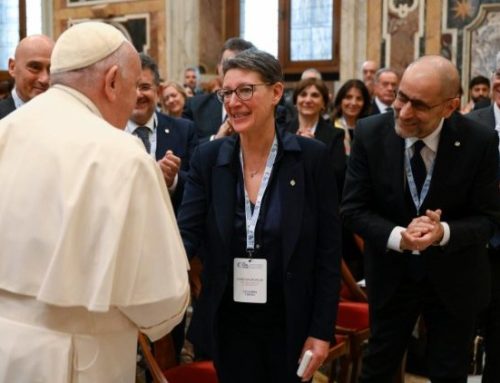Messaggio del Card. Peter Kodwo Appiah Turkson
Pubblichiamo di seguito il Messaggio del Prefetto del Dicastero per il Servizio dello Sviluppo Umano Integrale, l’Em.mo Card. Peter Kodwo Appiah Turkson, in occasione della 64.ma Giornata Mondiale di Lotta alla Lebbra (Morbo di Hansen) che si celebra domenica, 29 gennaio 2017:
Messaggio del Card. Peter Kodwo Appiah Turkson
Eradicazione della lebbra e reinserimento delle persone colpite dall’hanseniasi:
una sfida non ancora vinta.
La messa a punto di efficaci terapie farmacologiche e il forte impegno a livello planetario profuso da molti organismi e realtà nazionali ed internazionali, con la Chiesa Cattolica in prima linea, hanno inferto, negli ultimi decenni, un colpo durissimo al Morbo di Hansen, più noto come Lebbra. L’hanseniasi, che ancora nel 1985 affliggeva nel mondo oltre 5 milioni di persone, oggi annovera circa 200mila nuovi casi l’anno ma c’è ancora molto, moltissimo da fare.
Come fra l’altro evidenziato nel giugno scorso, a conclusione del Simposio “Per una cura olistica delle persone affette dal Morbo di Hansen rispettosa della loro dignità”, organizzato dall’allora Pontificio Consiglio per gli Operatori Sanitari: ogni nuovo caso di malattia di Hansen è di troppo, lo è anche ogni forma residua di stigma per questa malattia. Di troppo è ogni legge discriminante i malati affetti dal morbo di Hansen, così come ogni tipo di indifferenza. Nell’ambito dell’iniziativa, realizzata in collaborazione con la Nippon Foundation-Sasakawa Health Foundation e col contributo dell’Ordine di Malta e delle fondazioni Raoul Follereau e Il Buon Samaritano, è stato inoltre sottolineato che: dato il loro ruolo, è importante che i leader di tutte le religioni, nei loro insegnamenti, scritti e discorsi contribuiscano all’eliminazione della discriminazione contro le persone colpite dal Morbo di Hansen. È d’altro lato necessario, come anche ribadito successivamente dall’OMS durante il Forum Mondiale sull’hanseniasi tenuto a Seul nel mese di novembre, garantire cure fisiche e psicologiche ai pazienti durante e dopo la fine del trattamento.
Dobbiamo inoltre impegnarci tutti e a tutti i livelli perché, in tutti i Paesi, vengano modificate le politiche familiari, lavorative, scolastiche, sportive e di ogni altro genere che discriminano direttamente o indirettamente queste persone; perché i Governi mettano a punto piani attuativi che coinvolgano le persone malate.
Infine è fondamentale rafforzare la ricerca scientifica per sviluppare nuovi farmaci e ottenere migliori strumenti diagnostici così da aumentare le possibilità di diagnosi precoce. In larga parte, infatti, i nuovi casi vengono identificati solamente quando l’infezione ha già provocato delle lesioni permanenti e segnati, oramai a vita, l’adulto e il bambino o la bambina ammalatisi. D’altro lato accade che, specialmente nelle aree più remote, sia difficile garantire l’assistenza necessaria a terminare la cura oppure che gli stessi pazienti possano comprendere l’importanza o dare comunque la priorità al proseguimento del trattamento farmacologico eventualmente iniziato.
Ma le cure non bastano. Bisogna reinserire a pieno titolo la persona guarita nel tessuto sociale originario: nella famiglia, nella comunità, nella scuola o nell’ambiente di lavoro. Per promuovere e contribuire a tale processo di reintegrazione, peraltro ancora quasi impossibile in molte realtà, è necessario sostenere e incoraggiare ulteriormente l’associazionismo tra gli ex-malati; al contempo, insieme a loro, promuovere la diffusione delle comunità che, come già realizzato ad esempio in India, in Brasile e in Ghana, diventano delle vere famiglie che comprendono e accolgono le persone, offrendo un terreno fertile al mutuo aiuto, ad un’autentica fratellanza.
Anche riflettendo sulla guarigione operata da Gesù su di un malato di lebbra, come riportato nel capitolo 1 del Vangelo di Marco, il Cristo, “mosso a compassione, stese la mano, lo toccò e gli disse: «Lo voglio, guarisci!». Subito la lebbra scomparve ed egli guarì”. Poi “gli disse: «Guarda di non dir niente a nessuno, ma va’, presentati al sacerdote, e offri per la tua purificazione quello che Mosè ha ordinato, a testimonianza per loro».
Ecco che Gesù, dunque, non solamente sana la persona nella sua interezza ma sollecita l’uomo da Lui guarito a presentarsi a colui che poteva decretarne il pieno reinserimento nella società, la riammissione nel ‘consorzio umano’.
È forse questo, oggi come oggi, l’ostacolo maggiore da superare per chi è stato segnato dall’hanseniasi e chi opera in suo favore. Le disabilità, i segni inconfondibili lasciati dalla malattia sono ancora oggi simili a dei marchi a fuoco. La paura del Morbo, tra i più temuti nella storia umana, vince sulla ragione, la mancanza di conoscenza della patologia da parte della comunità esclude i guariti che, a loro volta, a causa della sofferenza e delle discriminazioni subite hanno perso il senso della dignità che gli è propria, inalienabile anche se il corpo presenta mutilazioni. “Per” loro e, soprattutto, “con” le persone rimaste vittime della lebbra dobbiamo impegnarci ancora più a fondo affinché possano trovare accoglienza, solidarietà, giustizia.
[00144-IT.01] [Testo originale: Italiano]
The eradication of leprosy and the reintegration of people afflicted by hanseniasis:
a challenge not yet won.
The development of effective pharmacological therapies and the major efforts at a planetary level of many national and international institutions and agencies, with the Catholic Church in the front line, over the last decades have inflicted a very severe blow on Hansen’s disease, known more commonly as leprosy. Hanseniasis, which in the year 1985 still afflicted over five million people in the world, today has about 200,000 new cases each year, but much – very much – still has to be done.
As for that matter was highlighted last June at the end of the symposium ‘Towards Holistic Care for People with Hansen’s Disease Respectful of their Dignity’, which was organised by the then Pontifical Council for Health Care Workers, every new case of Hansen’s disease is one case too many, as is every residual form of stigma attached to it. Every law that discriminates against patients with Hansen’s disease is one law too many, as is every form of indifference. Within the framework of the initiative promoted in cooperation with the Nippon Foundation-Sasakawa Health Foundation, with the contribution of the Order of Malta, the Raoul Follereau Foundation and the Good Samaritan Foundation, it was further emphasised that given their role, it is important for the leaders of all religions, in their teachings, writings and speeches, to contribute to the elimination of discrimination against people afflicted by Hansen’s disease. On the other hand, as was also emphasised subsequently by the World Health Organisation during the World Forum on hanseniasis held in Seoul in November, physical and psychological care should be assured to patients during and after the end of their treatment.
In addition, we should all commit ourselves – and at all levels – to ensuring that in all countries policies relating to the family, to work, to schools, to sport, and policies of every other kind, that directly or indirectly discriminate against these people are changed, and that governments develop implementing plans that involve people with this disease.
Lastly, strengthening scientific research in order to develop new medical products, and obtain better diagnostic instruments in order to increase the possibility of early diagnosis, is fundamental.
Indeed, in large part new cases are identified only when the infection has provoked permanent lesions and has marked, by now for life, the adults or boys or girls who have this disease. On the other hand, especially in the most remote areas, it is difficult to assure the assistance that is needed to finish the treatment or it is difficult for the patients themselves to understand the importance of – or anyway give priority to – continuing with the pharmacological treatment where this has been begun.
But treatment is not enough. A person who has been cured of this disease must be reintegrated to the full into his or her original social fabric: his or her family, community, school, or work environment.
In order to promote and contribute to this process of reintegration, which for that matter remains almost impossible in many contexts, associations of former patients should be further supported and encouraged. At the same time, the spread of communities, with these former patients, should be promoted which – as has already taken place, for example, in India, in Brazil and in Ghana – become real families who understand and welcome people, offering a fertile terrain for mutual aid and authentic brotherhood.
With reflection, as well, upon the healing of the man with leprosy by Jesus narrated in the first chapter of the Gospel According to Mark. Christ ‘Moved with pity…stretched out his hand, touched him, and said to him, “I will do it. Be made clean.” The leprosy left him immediately, and he was made clean’. Then he ‘said to him, “See that you tell no one anything but go, show yourself to the priest and offer for your cleansing what Moses prescribed; that will be proof for them”’.
Thus it was that Jesus not only healed the person in his entirety but also called on the man whom he healed to go to he who could declare his full reintegration into society, his readmission into the ‘human consortium’.
Perhaps today as yesterday this is a greatest obstacle to be overcome for those who have been marked by hansensiasis and for those who work for them. The disabilities, the unmistakeable signs left behind by this disease, are still today similar to brands. Fear of this disease, which is one of the most feared in human history, defeats reason; lack of knowledge by a community about this pathology excludes those who have been cured of it, who, in their turn, because of the suffering and the forms of discrimination that they have endured, have lost the sense of dignity that belongs to them and is inalienable even though their bodies have mutilations. ‘For’ them, and above all ‘with’ people who are victims of leprosy, we must engage ourselves more deeply so that they can find welcome, solidarity and justice.
[00144-EN.01] [Original text: Italian – working translation]









